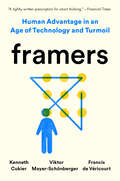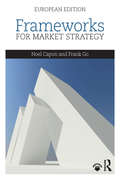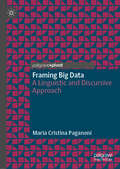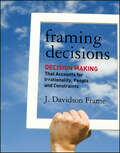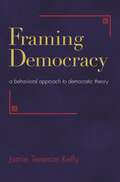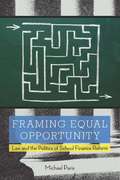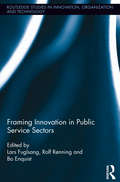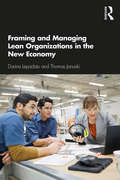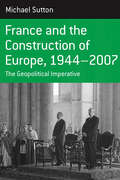- Table View
- List View
Framedia (A)
by Li Jin Li Liao Huabing LiExamines an acquisition in the highly competitive new media advertising industry in China in late 2005. The transaction leads to eventual consolidation of the industry and a positive stock market reaction. Discusses valuation in the context of an M&A transaction in an emerging economy and the role of private equity and venture capital in the development and the eventual consolidation of the new media advertising industry. Provides a context in which to discuss antitrust regulation, or lack there of, on an industrial organization in China.
Framedia (A) (Abridged)
by Carliss Y. Baldwin Li Jin Li LiaoExamines an acquisition in the highly competitive outdoor media advertising industry in China in late 2005. The transaction leads to eventual consolidation of the whole industry and positive stock reactions. Discusses equity consideration in the context of an M&A transaction, and the role of private equity and venture capital in the development and the eventual consolidation of the industry in emerging markets. Provides a context in which to discuss the impact of antitrust regulation, or lack thereof, on the industrial organization in China.
Framers: Human Advantage in an Age of Technology and Turmoil
by Viktor Mayer-Schönberger Kenneth Cukier Francis de VéricourtThe essential tool that will enable humanity to find the best way through a forest of looming problems is defined in Framers by internationally renowned authors Kenneth Cukier, Viktor Mayer-Schönberger and Francis de Véricourt. From pandemics to populism, AI to ISIS, wealth inequity to climate change, humanity faces unprecedented challenges that threaten our very existence. To frame is to make a mental model that enables us to see patterns, predict how things will unfold, and make sense of new situations. Frames guide the decisions we make and the results we attain. People have long focused on traits like memory and reasoning leaving framing all but ignored. But with computers becoming better at some of those cognitive tasks, framing stands out as a critical function—and only humans can do it. This book is the first guide to mastering this innate human ability. Illustrating their case with compelling examples and the latest research, authors Cukier, Mayer-Schönberger and de Véricourt examine: · Why advice to &“think outside the box&” is useless. · How Spotify beat Apple by reframing music as an experience. · What the historic 1976 Israeli commando raid on Entebbe that rescued over 100 hostages can tell us about how to frame. · How the #MeToo twitter hashtag reframed the perception of sexual assault. · The disaster of framing Covid-19 as equivalent to seasonal flu, and how framing it akin to SARS delivered New Zealand from the pandemic. Framers shows how framing is not just a way to improve how we make decisions in the era of algorithms—but why it will be a matter of survival for humanity in a time of societal upheaval and machine prosperity.
Framework for Action: Important First Steps
by Harvard Business Review PressEstablishing procedures and operational mechanisms before the real work begins on any project is crucial. A good deal of time can be lost on unproductive debates over making decisions, and communication is vital to moving beyond these obstacles. This chapter discusses how creating both an organizational plan, including a budget, and a communication plan can help to steer team members away from time-wasting activities and help to streamline the process.
Framework for Advancing Your Business Model
by Henry ChesbroughBusiness models are essential for converting ideas and technologies into economic value. However, business models are not all the same, nor do they all make the most of the opportunities offered by open innovation. This chapter lays out a systematic framework for evaluating and then improving your business model.
Framework for Analyzing Work Groups
by Michael B. MccaskeyPresents a model for understanding the behavior and evolution of primary, stable work groups over time. Model describes contextual factors, design factors and emergent culture as determinants of group behavior and performance. In addition, describes emergent behavior, norms, roles, and rituals as aspects of group life.
Framework for Pursuing Diversity in the Workplace
by Thomas J. Delong Michael BrookshireAssesses the costs and benefits of pursuing diversity and pinpoints the primary barriers to creating diverse workplaces. It also proposes some options for advancing diversity in an organization.
Framework for Risk Management
by David S. Scharfstein Jeremy C. Stein Kenneth A. FrootIn recent years, managers have become aware of how their companies can be buffeted by risks beyond their control. To insulate themselves from such risks, many companies are turning to the derivatives markets, taking advantage of instruments like forwards, futures, options, and swaps. Although heavily involved in risk management, most companies do not have clear goals underlying their hedging programs. Without such goals, using derivatives can be dangerous. The authors present a framework to guide top-level managers in developing a coherent risk-management strategy. That strategy cannot be delegated to the corporate treasurer--let alone to a hotshot financial engineer. Ultimately, a company's risk-management strategy needs to be integrated with its overall corporate strategy. A risk-management program should have one overarching goal: to ensure that a company has the cash available to make value-enhancing investments.
Frameworks for Market Strategy: European Edition
by Noel Capon Frank GoFrameworks for Market Strategy helps students understand how to develop and implement a market strategy and how to manage the marketing process. Marketing activity is the source of insight on the market, customers, and competitors and lies at the core of leading and managing a business. To understand how marketing fits into the broader challenge of managing a business, Capon and Go address marketing management both at the business and functional levels. The book moves beyond merely presenting established procedures, processes, and practices and includes new material based on cutting-edge research to ensure students develop strong critical thinking and problem-solving skills for success. In this European edition, Capon and Go have retained the strong framework of the book, but have updated the cases, examples, and discussions to increase the book’s relevance for students outside the USA. Key features include: • A strong strategic focus, teaching students how to analyze markets, customers, and competitors to plan, execute, and evaluate a winning market strategy • Practical examples from a range of contexts, allowing students to develop the skills necessary to work in for-profit, public, or non-profit firms • Emphasis on understanding the importance of working across organizational boundaries to align firm capabilities • Full chapters devoted to key topics, including brand management, digital marketing, marketing metrics, and ethical as well as social responsibilities • Focus on globalization with a chapter on regional and international marketing • Multiple choice, discussion, and essay questions at the end of each chapter Offering an online instructor’s manual and a host of useful pedagogy – including videos, learning outcomes, opening cases, key ideas, exercises, discussion questions, a glossary, and more – this book will provide a solid foundation in marketing management, both for those who will work in marketing departments, and those who will become senior executives.
Framing Big Data: A Linguistic and Discursive Approach
by Maria Cristina PaganoniThis book addresses big data as a socio-technical construct with huge potential for innovation in key sectors such as healthcare, government and business. Big data and its increasingly widespread use in such influential spheres can generate ethically controversial decisions, including questions surrounding privacy, consent and accountability. This book attempts to unpack the epistemological implications of the term ‘big data’, as well as the opportunities and responsibilities which come with it. The author analyses the linguistic texture of the big data narrative in the news media, in healthcare and in EU law on data protection, in order to contribute to its understanding from the critical perspective of language studies. The result is a study which will be of interest to students and scholars working in the digital humanities, corpus linguistics, and discourse studies.
Framing Challenge: What Is the Real Problem?
by Richard LueckeProperly framing a problem in terms of the reality of the situation and the objectives of the organization is an important second step in the decision-making process. Mental frames act to channel our thinking and are important tools to help navigate complex decisions. This chapter offers tips on how to frame a situation correctly, yielding better decisions in the end.
Framing Citizen Participation
by Anja RockeOriginally developed in Brazil, participatory budgeting is widely recognised as democratic innovation yet its concrete results vary greatly. Collating evidence from empirical and theoretical analysis, this book aims to provide an explanation for these varied results by analysing participatory budgeting in France, Germany and the United Kingdom.
Framing Decisions
by J. Davidson FrameThe economic crisis of 2008-2009 was a transformational event: it demonstrated that smart people aren't as smart as they and the public think. The crisis arose because a lot of highly educated people in high-impact positions-- political power brokers, business leaders, and large segments of the general public--made a lot of bad decisions despite unprecedented access to data, highly sophisticated decision support systems, methodological advances in the decision sciences, and guidance from highly experienced experts. How could we get things so wrong? The answer, says J. Davidson Frame in Framing Decisions: Decision Making That Accounts for Irrationality, People, and Constraints, is that traditional processes do not account for the three critical immeasurable elements highlighted in the book's subtitle-- irrationality, people, and constraints.Frame argues that decision-makers need to move beyond their single-minded focus on rational and optimal solutions as preached by the traditional paradigm. They must accommodate a decision's social space and address the realities of dissimulation, incompetence, legacy, greed, peer pressure, and conflict. In the final analysis, when making decisions of consequence, they should focus on people - both as individuals and in groups.Framing Decisions offers a new approach to decision making that gets decision-makers to put people and social context at the heart of the decision process. It offers guidance on how to make decisions in a real world filled with real people seeking real solutions to their problems.
Framing Democracy: A Behavioral Approach to Democratic Theory
by Jamie Terence KellyThe past thirty years have seen a surge of empirical research into political decision making and the influence of framing effects--the phenomenon that occurs when different but equivalent presentations of a decision problem elicit different judgments or preferences. During the same period, political philosophers have become increasingly interested in democratic theory, particularly in deliberative theories of democracy. Unfortunately, the empirical and philosophical studies of democracy have largely proceeded in isolation from each other. As a result, philosophical treatments of democracy have overlooked recent developments in psychology, while the empirical study of framing effects has ignored much contemporary work in political philosophy. In Framing Democracy, Jamie Terence Kelly bridges this divide by explaining the relevance of framing effects for normative theories of democracy. Employing a behavioral approach, Kelly argues for rejecting the rational actor model of decision making and replacing it with an understanding of choice imported from psychology and social science. After surveying the wide array of theories that go under the name of democratic theory, he argues that a behavioral approach enables a focus on three important concerns: moral reasons for endorsing democracy, feasibility considerations governing particular theories, and implications for institutional design. Finally, Kelly assesses a number of methods for addressing framing effects, including proposals to increase the amount of political speech, mechanisms designed to insulate democratic outcomes from flawed decision making, and programs of public education. The first book to develop a behavioral theory of democracy, Framing Democracy has important insights for democratic theory, the social scientific understanding of political decision making, economics, and legal theory.
Framing Equal Opportunity
by Michael ParisIn order to illuminate the crucial and often neglected role of legal translation in litigation-driven reform efforts, Paris (political science, City U. of New York-College of Staten Island) explores legal aspects--lawyers, rights claims, litigation, courts, and the like--in struggles to produce more egalitarian school finance and education policies. He focuses attention on would-be reformers and their mobilization of law and courts. Comparative case studies in New Jersey 1970-2009 and Kentucky 1983-2009 demonstrate details about the interplay between law and politics in litigation-based reform projects. Annotation ©2010 Book News, Inc. , Portland, OR (booknews. com)
Framing Innovation in Public Service Sectors (Routledge Studies in Innovation, Organizations and Technology)
by Rolf Rønning Bo Enquist Lars FuglsangInnovation is seen as an interactive process that involves many actors within and across organizational boundaries. In public sector services, innovation is a frequent, often holistic, and multi-layered process that involves many actors and many services at the same time. However, most of the existing literature on innovation in public sector services is based on the economics of innovation, which is heavily influenced by investigations of the private sector. Innovation in the Public Sector develops a more context-sensitive and rich approach in order to explore the different logics of innovation that prevail here. Rather than presenting a general theory of innovation, the book specifies how innovation and value creation are interconnected with social and institutional elements. Analytical constructs, including dynamic capability, absorptive capacity, and practice-based approaches, are reviewed and anchored in the organizational context of public sector services. Such a perspective on innovation can help us develop new understandings of the process and history of innovation, contributing to processual organizational analysis in a broader sense, and further developing present theories of organizational change.
Framing and Managing Lean Organizations in the New Economy
by Thomas Janoski Darina LepadatuThis book examines the dominance and significance of lean organizing in the international economy. Scholars from each discipline see lean production as positive or negative; the book blends theory with practice by sorting out these different academic views and revealing how lean is implemented in different ways. The first part synthesizes academic research from a range of disciplines—including, engineering, sociology, and management—to present the reader with an integrated understanding of the benefits and drawbacks of lean management. The second part links this theory to practice, with a set of case studies from companies like Apple, Google, Nike, Toyota, and Walmart that demonstrate how lean is implemented in a variety of settings. The book concludes with three models, explaining how Toyotism, Nikefication with offshoring, and Waltonism provide full or less complete models of lean production. It clearly presents the positive and negative aspects of lean and insights into the culture of lean organizations. With its rich interdisciplinary approach, Framing and Managing Lean Organizations in the New Economy will benefit researchers and students across a range of classes from management, sociology, and public policy to engineering.
Framing in Sustainability Science: Theoretical and Practical Approaches (Science for Sustainable Societies)
by Takashi Mino Shogo KudoThis open access book offers both conceptual and empirical descriptions of how to “frame” sustainability challenges. It defines “framing” in the context of sustainability science as the process of identifying subjects, setting boundaries, and defining problems. The chapters are grouped into two sections: a conceptual section and a case section. The conceptual section introduces readers to theories and concepts that can be used to achieve multiple understandings of sustainability; in turn, the case section highlights different ways of comprehending sustainability for researchers, practitioners, and other stakeholders. The book offers diverse illustrations of what sustainability concepts entail, both conceptually and empirically, and will help readers become aware of the implicit framings in sustainability-related discourses. In the extant literature, sustainability challenges such as climate change, sustainable development, and rapid urbanization have largely been treated as “pre-set,” fixed topics, while possible solutions have been discussed intensively. In contrast, this book examines the framings applied to the sustainability challenges themselves, and illustrates the road that led us to the current sustainability discourse.
Framing the Bride: Globalizing Beauty and Romance in Taiwan's Bridal Industry
by Bonnie AdrianA fascinating study of Taiwan's bridal industry. The norm in Taiwan has become extravagant Western-style weddings and lavish photos where bride and groom look like anything but themselves, and where certain family members are air brushed out. The book speaks to larger issues involving the importation of Western culture and its commodification.
Framing the Challenge: Develop an Entrepreneurial Mindset
by Rita Gunther Mcgrath Ian MacmillanWorried about managing your business through uncertain times? Take charge by adopting an entrepreneurial mindset--a way of thinking about your business that captures the benefits of uncertainty. Your first objective in creating an entrepreneurial mindset is to make sure that you have clearly established what your business needs to do to make the effort worthwhile. Frame what you must do to create a genuine win for your organization in terms of growth in both profits and profitability. This chapter provides some practical steps for getting started. This chapter is excerpted from "The Entrepreneurial Mindset: Strategies for Continuously Creating Opportunity in an Age of Uncertainty."
France And The Construction Of Europe, 1944-2007
by Michael SuttonIn the second half of the twentieth century France played the greatest role - even greater than Germany's - in shaping what eventually became the European Union. By the early twenty-first century, however, in a hugely transformed Europe, this era had patently come to an end. This comprehensive history shows how France coupled the pursuit of power and the furtherance of European integration over a sixty-year period, from the close of the Second World War to the hesitation caused by the French electorate's referendum rejection of the European Union's constitutional treaty in 2005.
France Telecom (A): A Challenging Restructuring
by Cynthia A. Montgomery Ashley V. WhillansThese cases explore the impacts of industry shocks, resulting corporate actions that had a devastating impact on employees, and the legal conviction of corporate leaders for "institutional harassment. This case series follows the evolution of France Telecom from a national telephone monopoly to a private company facing two severe challenges: (1) The company's competitive advantage as a land-line carrier is being challenged by mobile carriers and the entry of new competition from other countries; and (2) the workforce is much larger than required by the company's new strategy, yet many employees are civil servants, making it very difficult to reduce headcount, despite many attempts to do so. As increasing pressure is mounted internally, the culture shifts from one where employees are proud to work to one described as "tense, even violent" and the physical and mental wellbeing of some employees becomes increasingly "fragile." The further impact of these developments is outlined in the (B) and (C) cases. The (A) case describes the development of the situation, the competitive challenges that prompted it, key decisions made by corporate leaders, and the impact of the same on various stakeholders. The discussion begins by asking students to apportion responsibility -how much is due to labor laws, to industry change; to past management; to current management; to the employees themselves? Have corporate leaders pushed employees too far, creating unacceptable levels of stress and unhappiness? What levers do leaders have to keep a business relevant and to do so in a way that is fair to all stakeholders? At its most fundamental, the case series helps students confront some fundamental tensions between the pressures and benefits of capitalism, the responsibilities of management, and the day-to-day and long-term impacts on employee well-being.
France Telecom (B): A Wave of Staff Suicides
by Cynthia A. Montgomery Ashley V. WhillansIn the B case we learn that at least 19 France Telecom employees took their own lives between 2006 and 2009, 12 others attempted suicide, and eight suffered from serious depression for reasons reportedly related to work. Some of these deaths occurred in public places, others on company grounds. Labor inspector Sylvie Catala conducted an investigation and found that the "lack of consideration or psychosocial risks in the restructuring is the result of a policy implemented throughout the country... and that the company's top executives put pressure on middle management , who passed on this pressure to workers." She concluded that the company's actions likely "endangered human life" and constituted "moral harassment."

